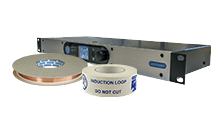The EU Accessibility Act (EAA) came into force on 28 June 2025, requiring public-facing organisations to provide accessible services including access to spoken information for people with hearing loss.
If your venue provides spoken information to the public whether via announcements, ticket desks, guided tours or performances, assistive listening systems (ALS) may be required under the new regulations.
If your venue isn’t fully compliant yet, don’t panic, there’s still time to take meaningful steps toward accessibility and legal alignment.
Here are five practical steps to help you prepare and ensure your venue is compliant, inclusive, and future-ready.
- Audit Your Current Systems
Start with a full review of your existing accessibility provisions. Are there hearing loops installed? Are they functioning correctly? Are there areas where no assistive listening is available at all?
Check:
- Front desks, ticket counters, and reception areas
- Meeting rooms, auditoriums, and public seating areas
- Places of worship, heritage sites, or anywhere public information is spoken
If you're unsure, a professional site survey can identify gaps and opportunities.
- Understand EN 301 549 and Hearing Loop Standards
The EAA references EN 301 549, the European standard for accessibility of ICT products and services. It requires that venues offering audio content provide equivalent access for people who are deaf or hard of hearing.
For assistive listening, this means your systems should meet recognised technical standards such as IEC 60118-4 for induction loops to ensure reliable, intelligible sound quality.
You can read more about EN 301 549 here (ETSI official publication).
- Upgrade or Retrofit with Compliant ALS
If your systems are outdated, underperforming, or missing entirely, now is the time to act. There are multiple assistive listening technologies available:
- Hearing Loops – Ideal for fixed venues, compatible with most hearing aids
- Infrared (IR) – Secure audio for sensitive environments like courtrooms
- Radio Frequency (RF) – Great for multi-room or mobile setups
- Auracast™ – Deliver audio directly to hearing aids, cochlear implants, earbuds and dedicated receivers
- Audio over WiFi – Stream high-quality audio via existing wireless networks to smartphones and dedicated receivers, offering flexible, scalable coverage for modern venues
We can help you determine the most effective and compliant solution for your venue and audience.
- Train Your Staff
Even the best systems are underused if staff aren’t confident in how they work. Include basic ALS awareness in staff training, such as:
- Knowing where systems are installed
- How to offer receivers or alternative solutions
- What to do if a system isn’t working
Staff who understand accessibility are key to an inclusive visitor experience.
- Communicate Accessibility to Your Visitors
Once you have compliant systems in place, tell people about them. Clear signage, website information, and staff awareness all help ensure your assistive listening provisions are actually used by those who need them.
- Add hearing loop or ALS symbols to entrances, desks, and brochures
- Include accessibility details on your website and booking platforms
- Encourage feedback to continue improving
Promoting accessibility isn’t just about ticking a compliance box, it’s about inclusion, dignity, and belonging.
Ready to Prepare Your Venue?
Ampetronic | Listen Technologies bring together over 60 years of combined experience in assistive listening. We can recommend solutions, and ensure your systems meet the latest legal and technical standards.
Contact us and take the first step towards making your venue truly accessible.


